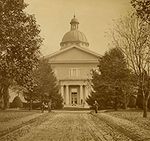Portal:Featured Article Of The Week
Featured Article Of The Week
Institute of the Pennsylvania Hospital
The new superintendent, Thomas Story Kirkbride, gained national renown because of his particular clinical methods. He developed a more humane way of treatment for the mentally ill that became widely influential within American Psychiatry. Today, the former Institute campus exists as a multi-purpose social-service facility. The new hospital, located on a 101-acre (0.41 km²) tract of the as yet unincorporated district of West Philadelphia, offered comforts and a “humane treatment” philosophy that set a standard for its day. Unlike other asylums where patients were often kept chained in crowded, unsanitary wards with little if any treatment, patients at Pennsylvania Hospital resided in private rooms, received medical treatment, worked outdoors and enjoyed recreational activities including lectures and a use of the hospital library. The campus originally featured one, but later, two hospital buildings, which were separated by a creek and pleasure grounds.
The first building was a long thin building located west of the Schuylkill River. This building would eventually become the female department. Though the building does reflect the Kirkbride Plan it was actually constructed before Dr. Kirkbride was given full supervisory duties. Construction began under the control of architect Isaac Holden, but later illness forced Issac to return to his home country of England. The building was then finished by a young Samuel Sloan, who had previously worked as a carpenter on Eastern State Penitentiary. Sloan finished the building in 1841 using Holden's plans. The building was a rather simple design compared to later Kirkbride Plan buildings. Constructed of cut limestone, it was three stories tall with a central administration section flanked on either side by a set of wings. The top of the administration section was crowned with a large dome. On both the front and back of the administration section were stone porticoes. The interior of the building was well furnished, the lavishly carpeted corridors were twelve feet wide. The building features iron stairs, well lighted wards, and iron water tanks in the dome over the administration section, which provided fresh water to all of the building. Click here for more...
